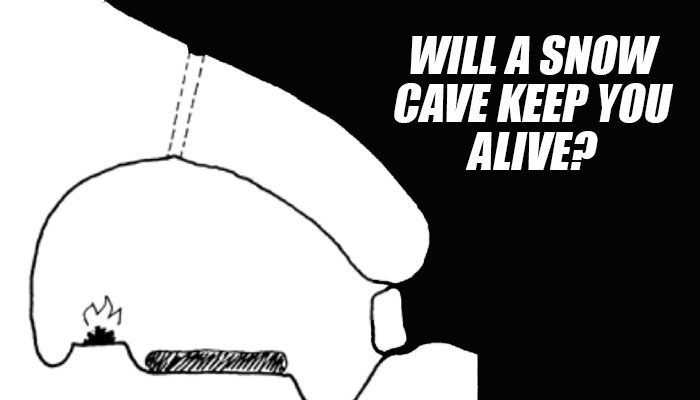
First, let’s define the difference between a snow cave and a Quinzee. A Quinzee is made by shaping snow into a dome-like structure and then hollowing out sleeping quarters inside. The word Quinzee comes from the indigenous peoples of Alaska and Northern Canada.
A snow cave, on the other hand, is typically a hole dug into a large snowdrift or into deep snow. The snow is displaced from its location, in other words. To construct, you simply dig into deep snow to create a sleeping chamber. There are advantages and disadvantages, however to either one. The snow cover and geographic location may determine which one you construct.
If there is not snow deep enough to dig into so you can create space, you would gather the snow up and construct a Quinzee. Whereas, if the ground is well covered in deep snow, then gathering snow to create a dome would not be practical, so instead you would simply excavate the deep snow to make your shelter.
Will Snow Keep You Warm
Snow will keep you warmer, but this does not necessarily mean it will keep you warm enough to survive. Snow is nothing more than frozen ice crystals that can sustain their shape on the ground if the air temperature is below freezing. Snow is also full of air pockets, which will benefit you because air pockets do act as an insulator.
Back to the question, will snow keep you alive? If the air temperature is, for example, -15° F then you would have a very difficult time surviving unprotected, but what if you could increase the air temperature to let’s say 32° F. You would have a much easier time surviving right, of course, you would.
A snow cave or Quinzee if done correctly can maintain an inside temperature of 32° F or even warmer, and this even if the air temperature outside is minus 30° F. Your world just became much warmer, but you can easily succumb to hypothermia at this temperature without the proper protection.
It is assumed you would have cold weather clothing, sleeping materials, and a ground cloth or ground insulators to raise you off or to protect you from the cold ground. You would also need a way to block cold air from entering the entrance.
You need ventilation holes as well and possibly a chamber dug lower than the one you plan to sleep in. A lower chamber would allow the colder air in your chamber to settle away from your body.
Anytime you burrow into the snow, you stand the chance of becoming trapped and dying. A snow dome or Quinzee can collapse as well, but the volume of snow would be likely less than if, you dug 4 or 5 feet into a snow bank. Having your snow shelter collapse is a very real possibility. Ensure you have a shovel inside, poles long enough to poke air holes up through the snow with, and a personal beacon to alert others as to your location.
Having a shelter that protects against cold winds, rain or snow will dramatically increase your chances of survival.
You need insulation between your body and the cold ground or snow cover. Pine boughs, leaves, sticks, and/or ground insulators you brought with you will be needed. The heat generated by your body would conduct to the colder ground as you slept.
Hot food and liquids will be needed as well as clean drinking water. Dehydration is a problem regardless of the air temperature, and your body may not signal that it is thirsty, so it is important you drink water throughout the day, and especially during meals to help the digestive process. Empty your bladder before going to sleep and always eat before going to bed. The digestive process helps maintain your body’s core temperature.
Ground insulation is important, so you must pay particular attention to it. A sleeping bag is not enough between you and the cold ground.